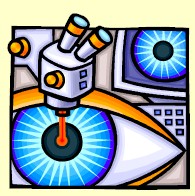![]()
![]()
Laser Correction of Myopia
|
You are visiting the most popular topic of the Day! "Laser your eye and your 'number' disappears!" That is the talk of the town! Laser procedure for Myopia correction is mainly of two types.
Photorefractive Keratectomy (PRK)
PRK uses Excimer laser. The outermost layer of the cornea - The epithelium is scrapped off. Precise excision of layers of cornea underneath is carried out with the laser. The thickness of cornea excised depends on the degree of myopia. That's all! This changes the ability of the cornea to bend the light that enters the eye. Thus light can now get focused on the retina, instead of in the front of it. Thus the Myope is able to see without spectacles! See What's New?....Corneal Mapping. Advantages of PRK:
LASIK- Laser in situ KeratomileusisWith the Excimer laser, a flap of the top layers of cornea is made, and the inner layers are excised with Laser. The flap is put back. The thickness of the excised cornea depends on the myopia. Advantages:
The Excimer laser got FDA approval in 1998. The laser procedures are costly and are generally not covered by the health insurance. Besides correction of the 'number' or the refractive error, Lasers have been used very widely in treatment of various eye problems. Lasers in treatment of eye diseases
|
